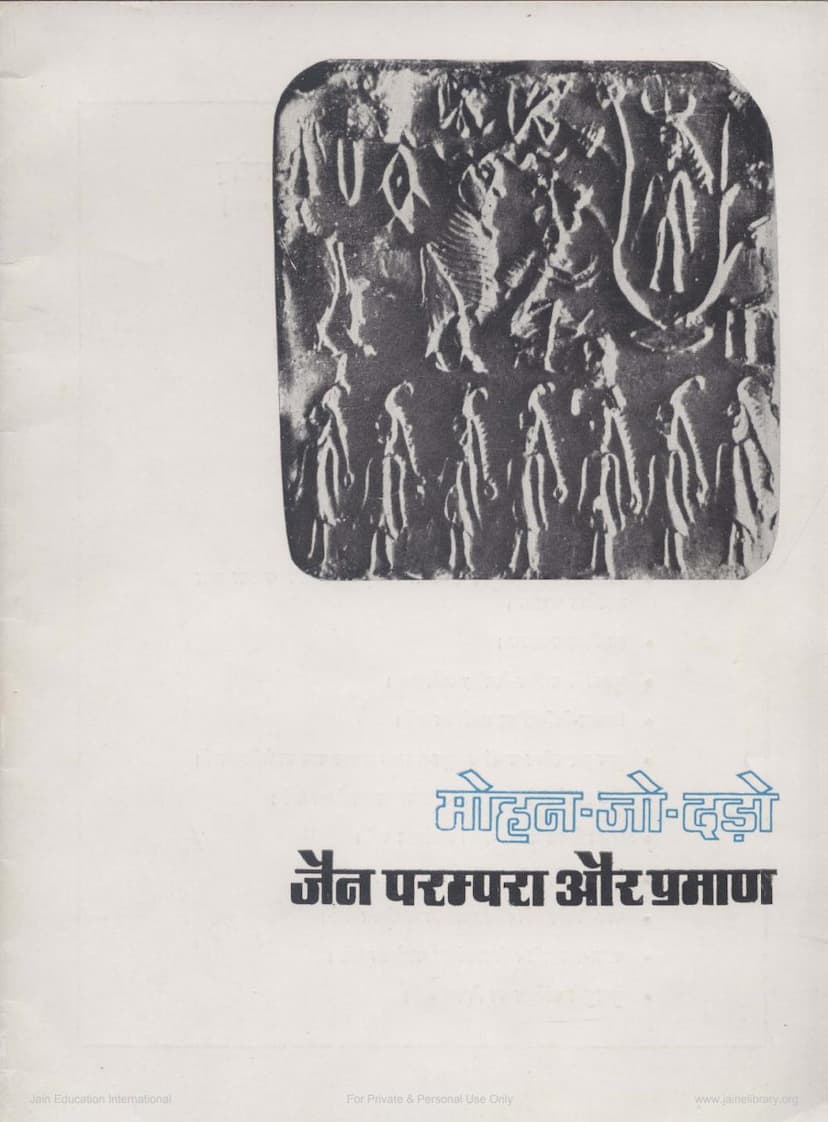Mohan Jo Dado Jain Parampara Aur Praman
Added to library: September 2, 2025

Summary
Here's a comprehensive summary of the Jain text "Mohan Jo Dado Jain Parampara aur Praman" by Acharya Muni Vidyanand:
Book Title: Mohan Jo Dado Jain Parampara aur Praman (Mohenjo-daro: Jain Tradition and Evidence) Author: Acharya Muni Vidyanand Publisher: Kundkund Bharti Trust
Core Argument: The central thesis of this book is that archaeological findings from Mohenjo-daro, particularly the seals discovered, provide compelling evidence for the ancient and deeply rooted presence of Jainism in India. The author argues that Jainism predates the Vedic period and was an integral part of the Indus Valley Civilization.
Key Points and Arguments:
-
Challenging Established Timelines: The book directly challenges the prevailing notion that the Rigveda represents the earliest point of Indian culture and civilization. The Mohenjo-daro excavations, dating back at least 5000 years (3250 BCE), reveal a sophisticated civilization that the author contends was heavily influenced by or was itself Jain. This pushes the timeline of Indian civilization and Jain tradition significantly further back.
-
Evidence from Mohenjo-daro Seals: The primary evidence presented comes from the seals unearthed at Mohenjo-daro. These seals are interpreted as depicting:
- Kāyotsarga (Kayotsarga) Posture: Numerous seals show figures in a standing, contemplative pose with arms hanging down. This posture is identified as kāyotsarga, a distinct and characteristic meditative posture in Jainism, often associated with the first Tirthankara, Rishabhnath. The book emphasizes that this posture is peculiar to Jain tradition.
- Nudity (Digambaratva): The figures in the kāyotsarga posture are depicted as nude, which aligns with the Jain principle of digambaratva (sky-clad or unclothed) for ascetics.
- Emblem of the Bull (Vrishabha): The bull, the emblem (lañchan) of Rishabhnath, is frequently depicted on the seals, further strengthening the connection to the first Jain Tirthankara.
- Spiritual and Yogic Practices: The seals are seen as evidence of advanced yogic practices and a spiritual culture prevalent in the Indus Valley. The book argues that the yogic tradition originated with the Kshatriyas, who passed it on to Brahmins.
- Rishabhnath as the Pioneer: The book strongly posits that the seals prove Rishabhnath, the first Tirthankara, was the originator of the spiritual (Adhyatma) tradition, specifically yoga, and was highly revered in Mohenjo-daro culture.
-
Jainism as Pre-Vedic and Indigenous: The author asserts that Jainism is not only pre-Vedic but also an indigenous tradition of India. The findings suggest that Jain spiritual and philosophical ideas were deeply integrated into the Indus Valley Civilization.
-
Social and Economic Standing of Jains: The book highlights that based on the analysis of archaeological findings by scholars like Ramprasad Chanda and Iravatham Mahadevan, Jains held a significant social status in the Indus Valley Civilization. They were respected in the trade world, had financial credibility, and their trade practices and instruments (like bills of exchange, hundis) were widespread and well-regarded.
-
Jain Iconography and Symbolism:
- Trishul (Trident): The trident is identified as a symbol representing the Ratnatraya (three jewels: Right Faith, Right Knowledge, Right Conduct) in Jainism, and its presence on seals connects to Jain iconography.
- Kalpavriksha (Wish-fulfilling Tree): The depiction of a Kalpavriksha surrounding the kāyotsarga figure is also seen as a significant symbol, with parallels in Jain literature.
- Swastika: The Swastika, a prominent symbol of good fortune in Jainism (representing the four states of existence: hellish beings, animals, humans, and celestial beings, with the three dots symbolizing the Ratnatraya and the crescent symbolizing liberation), was also found on Indus seals, further linking the cultures.
- Bharat Chakravarthi: The seals also depict Bharat Chakravarthi, the eldest son of Rishabhnath, in a posture of devotion, reinforcing the historical narrative from Jain scriptures.
-
Linguistic Connections: The author touches upon the possibility that the Indus script might be related to Brahmi, which in Jain tradition is said to have been taught by Rishabhnath to his daughter. The prevalence of Prakrit language in Jain religious texts is also cited as evidence of its ancient, possibly pre-Vedic, and Indus Valley connection.
-
Jain Dharma as the Original Spiritual Tradition: The book argues that Jainism is the original spiritual (Adhyatma) religion of the world. Rishabhnath is presented as the founder of civilization, teaching essential skills like warfare (Asi), trade (Masi), agriculture, and spiritual knowledge. The name "Bharatvarsha" is attributed to Bharat, son of Rishabhnath, not the son of Dushyanta.
-
Call for Further Research: The book concludes by emphasizing that this work is a starting point and urges historians and archaeologists to conduct more thorough research, analyzing the Mohenjo-daro artifacts in light of Jain literature, traditions, and iconography to fully understand the ancient connections.
In essence, the book "Mohan Jo Dado Jain Parampara aur Praman" by Acharya Muni Vidyanand presents a strong case, based on archaeological evidence from Mohenjo-daro, that Jainism is an extremely ancient tradition, predating the Vedic period and forming an integral part of the Indus Valley Civilization, particularly evident through the depiction of kāyotsarga posture, the bull emblem, and other associated symbols on the seals.